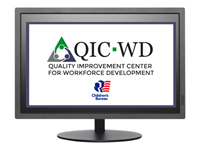Child Welfare Quality Improvement Center for Workforce Development (QIC-WD)
Date of this Version
7-2022
Document Type
Article
Abstract
Exploration of Need
The QIC-WD and the Louisiana Department of Child and Family Services (DCFS) Child Welfare Division (CWD) worked together to conduct a needs assessment. A variety of information was explored to learn about the current workforce and the agency’s child welfare workforce practices, including: 1) recruitment, hiring, and retention metrics and processes; 2) organizational culture and climate; and 3) other workforce processes and initiatives, such as onboarding, mentoring, supervision, performance management, and employee recognition.
More specifically, five major types of information were considered: 1) objective administrative data; 2) subjective perceptions of staff and supervisors, gathered through QIC-WD surveys; 3) expertise and input of agency leadership and the project implementation team; 4) QIC-WD team expertise and feedback; and 5) Louisiana Civil Service Commission job audit interviews with DCFS staff. The goal was to identify areas of need that could be addressed through a workforce intervention that met a set of QIC-WD criteria.
Identification of Priority Needs
Results of the needs exploration revealed that high caseloads and the large number of administrative tasks were barriers to caseworkers’ ability to effectively engage in the clinical aspects of their work, including engaging and providing support to families, determining the root causes of abuse and neglect, and implementing appropriate services in a timely manner. Due to the overload of tasks and high turnover, supervisors and managers were regularly working “out of level,” in that many supervisors carried caseloads (essentially functioning as a frontline worker) and then managers were functioning as case work supervisors. Agency leaders recognized the challenges they were facing and expressed a desire to creatively re-envision how frontline child welfare work could be performed more effectively, including how to get services to families sooner to try to prevent removals from the home.
Intervention Selection
To determine which intervention to implement, the following QIC-WD criteria were considered: 1) alignment with agency need, 2) level of existing evidence of effectiveness, 3) applicability to other agencies’ needs and circumstances, 4) scope and magnitude, relative to agency and QIC-WD capacity, 5) evaluation potential, 6) contribution to a diverse array of interventions across QIC-WD sites, and 7) agreeable to both the agency and the QIC-WD. The QIC-WD team and CWD leadership recognized the unique opportunity to collaborate to develop what could become a transformative solution with relevance for other agencies nationwide. The QIC-WD engaged in discussions with the leadership and implementation teams about the general process of job redesign and the anticipated level of time, focus and resources required to design and implement this type of extensive intervention. After careful consideration, the agency decided to engage in a job redesign for its intervention because it had the potential to address the imbalance between the large number of administrative tasks and the need to the effectively engage with families. The intervention also offered the opportunity to potentially alleviate issues with task overload that were forcing supervisors and managers to work out of level.
Included in
Industrial and Organizational Psychology Commons, Performance Management Commons, Public Policy Commons, Social Welfare Commons, Social Work Commons, Training and Development Commons


